|

|
|
Two legs give way, killing experienced installer
June 30, 2009 - When Larry Prelog suffered a fatal fall from a radio tower Saturday at a ham radio demonstration in Watervliet, Michigan, he was doing the routine task of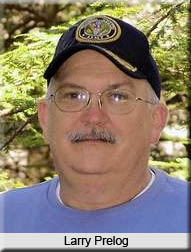 installing an antenna. installing an antenna.
It was something the 57-year-old Niles man had done time and time again as a professional installer of radio equipment and radio towers, said Matt Severin, spokesman for the Blossomland Amateur Radio Association.
Prelog's daughter, Mindy Bittle, of Akron, Ohio, said the 57-year-old Prelog had a 40-year background in telecommunications tower installations and had climbed towers as high as 500 feet.
Although he never discussed the dangers of his profession with his family, he didn't take chances when he was on a job, Bittle said.
Severin said Prelog was at the top of the radio tower, attached by a safety harness lanyard, when it fell down sideways, crashing him to the ground.
"The tower failed at the base," Severin said.
Two of three metals legs at the base bent and buckled, causing the tower to lurch sideways and collapse. It was not immediately known who the tower manufacturer was.
The tower was anchored into the ground at the base and stabilized by guy wires, and it not known what caused the metal braces to give way, Severin said.
Severin said Monday that the tower was 30 feet tall and Prelog was as the top when it toppled over.
Climbing the tower is a common way to install an antennae on a tower of that height, and Prelog was following proper safety measures, Severin said.
Prelog died Sunday morning at Borgess Hospital in Kalamazoo from injuries suffered in the fall. He is survived by a wife, two daughters and a son.
He was employed as Andrews University's telecommunications manager since 1994.
|
|
FCC test tells Floyd, New York residents that their mast hysteria is unfounded
June 30, 2009 - Last month, Floyd, New York resident Steve Lloyd suddenly heard music from God's Country radio playing from his bedroom TV and then he later noticed that the WOKR FM radio station broadcast at 93.5 FM , came in on other frequencies in his home. , came in on other frequencies in his home.
Lloyd called the local media and told them that he and his wife started getting headaches and diarrhea, felt nauseous and tired, and blisters started appearing on their skin, forcing them to move to a camp they owned 25 minutes away on Kayuta Lake.
Their physical ailments, he said, were being caused by WOKR's new radio antenna recently added at the 80-foot level on an American Tower Corporation tower adjoining the rear of his property on Soule Road. He said for 20 years he never had a problem, but the recent FM antenna installation has deteriorated his family's health.
Lloyd contacted Mid-State Communications & Electronics, Inc. out of Oriskany and the company said that radio frequency in his home exceeded safe levels, according to Lloyd, who declined to share the report.
A spokesperson for Mid-State, however, said his firm provided readings only and did not provide a report as described by the local press. He stated that the readings did not come close to any thresholds that would be a concern to the Federal Communications Commission.
Please see: FM flu caught by neighbors, politicians and media
.
|
|

0 - The number of opinions found that were made by U.S. Supreme Court nominee Sonia Sotomayor that raised serious concerns by the CTIA - The Wireless 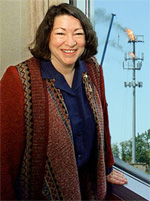 Association, and PCIA - The Wireless Infrastructure Association, as to whether her appointment could adversely affect pending telecommunications issues. Association, and PCIA - The Wireless Infrastructure Association, as to whether her appointment could adversely affect pending telecommunications issues.
The two trade groups try to read the tea leaves of how appointments will affect their members' hot topics.
The last nominee that had an opinion directly related to the communications siting community was Justice John Roberts. In that case, the U.S. Court of Appeals for the D.C. Circuit concluded that it lacked jurisdiction over the petitioner's claim that a BellSouth 185' monopole was constructed without an environmental assessment. See SHPO snafu
If elevated to the U.S. Supreme Court, Judge Sotomayor would become the first justice to join the court with a history of precedent-setting rulings on cyberlaw issues, legal experts say.
2 - If a proposed assembly bill is passed, it will be the maximum number of axels (or a gross vehicle weight of 5 tons) that a commercial vehicle can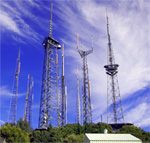 have if it is using State Route 2, from Foothills to Big Pines in the County of Los Angeles, Calif., a heavily traveled road that maintenance workers use to service their towers on Mt. Wilson. have if it is using State Route 2, from Foothills to Big Pines in the County of Los Angeles, Calif., a heavily traveled road that maintenance workers use to service their towers on Mt. Wilson.
Representatives of American Tower Corporation, Sea West Enterprises, Inc., Wireless Infrastructure Services, and other companies believe that this restriction will severely cripple the occupants and businesses that have tower facilities on Mt. Wilson and other surrounding sites within the Angeles National Forest. They're suggesting that industry companies should contact their government officials and register their concerns.
23 - Is the percentage of land that Crown Castle International owns beneath its towers, explained Jay Brown, the company's CFO in a  presentation to capital markets recently. He also said that CCI is forecasting a 9 percent growth rate in site rental revenue for 2009 and the company has enough cash flow to pay all debt maturities through March 2014. CCI's average ground lease maturity is over 30 year, Brown said. presentation to capital markets recently. He also said that CCI is forecasting a 9 percent growth rate in site rental revenue for 2009 and the company has enough cash flow to pay all debt maturities through March 2014. CCI's average ground lease maturity is over 30 year, Brown said.
Most of CCI's site revenue, 79 percent, comes from the big-four wireless carriers: Verizon Wireless, AT&T, T-Mobile, Sprint. Brown believes that since CCI is located in the country's largest markets, it will assist with the quality of the tower company's revenue stream due to the growth of data and cell site density.
American Tower Corporation receives 65 percent of its revenue stream from the big four and SBA Communications's percentage is 62, according to CCI.
55 - The number of firefighters and other emergency workers it took to rescue two tower techs stuck in the basket of a hydraulic boom on June 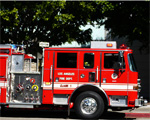 15 at 8:42 p.m. The workers were at approximately 40 feet of a 50-foot high relay radio tower making repairs when they experienced difficulties maneuvering the boom basket at 2050 N. Cyprean Dr. in Hollywood Hills in Los Angeles County, Calif. 15 at 8:42 p.m. The workers were at approximately 40 feet of a 50-foot high relay radio tower making repairs when they experienced difficulties maneuvering the boom basket at 2050 N. Cyprean Dr. in Hollywood Hills in Los Angeles County, Calif.
First responders realized that heavy equipment could not be brought in. Light vehicles and a heavy equipment operator were requested to assist at the scene.
Los Angeles Firefighters began the daunting task of hand carrying and setting up, rescue equipment, generators and lights . As the aerial ladder truck slowly trudged up the narrow private road, firefighters began stabilization operations to the boom. It took an hour and a half to safely bring them down.
The two technicians left immediately following the successful rescue. Los Angeles Fire Department officials were unable to get their names or the contractor that employed them, according to a LAFD spokesperson.
86.6 - In millions, the number of subscribers that Verizon Wireless had at the end of last quarter, followed by the nation's second largest  carrier, AT&T at 78.2 million; Sprint/Nextel, 49.1 million and T-Mobile, 33.2 million. carrier, AT&T at 78.2 million; Sprint/Nextel, 49.1 million and T-Mobile, 33.2 million.
While the big four are looking at their competition's numbers, US Senator Herb Kohl (D-Wisconsin) has asked the Federal Communications Commission to look at their 100% increase in the price of SMS text messages from 2006 to 2008. He believes it might be "the result of a lack of competition."
Kohl wants to identify if the four major wireless carriers, especially AT&T and Verizon Wireless, violated anti-trust laws by colluding to increase SMS text message prices over the years. All four major US wireless carriers have increased the price of their text messages from 10 cents to 20 cents, but Verizon Executive VP and general counsel Randal Milch denies any collusion - pointing out that carriers offer different pricing for prepaid plans.
1,800 - The number of miles you could travel if you placed end to end all of the Rohn 25G tower sections that  have been sold since 1948. If you kept them less than six feet off the ground, you wouldn't have to wear cumbersome safety equipment and you could easily traverse them from Peoria, Il. to Las Vegas. Plus, you'd still have enough sections left over to go up and down the strip at least 25 times. have been sold since 1948. If you kept them less than six feet off the ground, you wouldn't have to wear cumbersome safety equipment and you could easily traverse them from Peoria, Il. to Las Vegas. Plus, you'd still have enough sections left over to go up and down the strip at least 25 times.
Or, if you believe that bidding telecom projects is enough of a gamble, in lieu of Vegas you can reroute the sections to a slightly more sedate community - the sleepy hamlet of Markerville, Alberta, Canada - where you'll discover one of the town's most popular attractions, a 15-foot-tall cream can and wheat statue.
At a distance of 1,797 miles from Rohn's West Plank Road loading dock, you'll have plenty of tower sections left to actually climb to the very top of the iconic symbol that recognizes the creamery and agricultural industries of the area. If you're going to visit Markerville and run a river of 25Gs through it, remember, what happens there stays there with their 50 residents.
|
|
New Jersey cell tower technician takes a
humorous poke at David Letterman
June 18, 2009 - There's an excellent chance that Alaska Governor Sarah Palin's daughter, Willow, may replace her New Kids on the Block poster with a new heartthrob, New Jersey tower technician Christian Rios who made David Letterman look a little foolish, a while before the late night talk show host accomplished that task on his own. heartthrob, New Jersey tower technician Christian Rios who made David Letterman look a little foolish, a while before the late night talk show host accomplished that task on his own.
While working on a cell site atop the Ed Sullivan Theatre in Manhattan where Letterman tapes his nightly show, the tower tech found a convenient spot to temporarily and artistically park two-inch tape for a transmission line connector he was waterproofing.
Letterman's monologue on June 8 included a joke about Governor Palin's daughter being "knocked up" by Alex Rodriguez during the seventh inning stretch of a Yankees game.
Letterman later claimed he thought he was joking about 18-year-old Bristol Palin, who did get pregnant. The problem for Letterman was, the Palin daughter who attended the game was Willow, who is 14.
Although Governor Palin accepted Letterman's apology on Tuesday, the nation doesn't appear to be ready to tune out the controversy. Believing abstinence is not always the best policy, we offer our:
Top Ten Reasons why aging David Letterman
would never make it as a tower climber:
10 Paid sick time can't be used for eyelid tucks and lip implants
9 Used to a four hour workday, it would be difficult to complete an OSHA 10-hour course
8 Hoists can't be safely adapted to use The Clapper
7 Bruno Magli doesn't make ANSI-approved steel-toed boots
6 According to Bechtel, a Miracle Ear will provide false readings with RF test equipment
5 Manufacturers stopped making double-breasted safety harnesses in the early 1970s
4 To avoid another child at age 62, his considerably younger wife would have to be flown in during A-Rod's off season
3 Would think a foreman's request to pick up a 25G would be beneath him for such a small amount of cash
2 Would tell a tasteless joke about Sprint CEO's daughter's inappropriate use of a smart phone, then apologize, later saying he was really referring to Nextel's CEO's child
1 Would demand $30 million a year, forcing NBC's Tower Dogs' Ernie to drag up if he didn't get a raise above his $14 an hour
|
|
Farmer's hay day results in toppled Missouri tower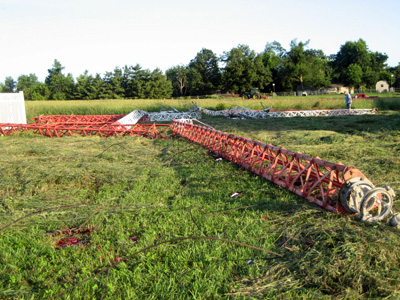
June 17, 2009 - A farming accident toppled a KFEQ broadcast tower yesterday around 7:10 P.M. No one was injured and station officials were on site within minutes to secure the area. The fallen tower was part of a four array AM tower system just north of the North Shoppes in Andrew County, MO.
A farmer was mowing hay when he hit one of the structure's guy wires.
Sherriff's officials were notified and have visited the site. A station manager said work has already started to bring the site into compliance with FCC requirements. KFEQ will be sending an emergency request authorization to the FCC to operate at reduced power. The station's daytime reception should not be affected, but its nighttime signal would be changed.
|
|
Carrier's rural vision dashed, leaving contractors and suppliers holding over $86 million in claims
June 15, 2009 - Two years ago, Crossroads Wireless, headquartered in Oklahoma City, Okla., began building out their network with ambitious plans to offer mobile 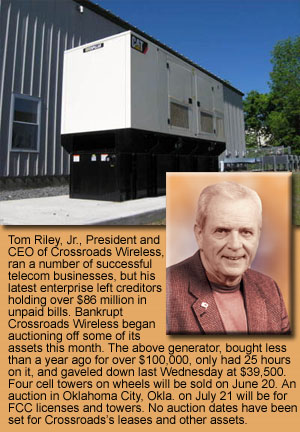 voice, data and high-speed broadband products via a long-term roaming relationship with Sprint/Nextel and by using their own FCC licenses. voice, data and high-speed broadband products via a long-term roaming relationship with Sprint/Nextel and by using their own FCC licenses.
When fully built out, Crossroads said they would be the 11th largest 850 / 1900 MHz wireless carrier in the U.S. in terms of population covered.
The carrier's initial launch was scheduled for the first quarter of 2008 and its network was expected to quickly grow to cover rural Americans in over 34 states. Contractors and suppliers were anxious to be part of the build-out and embraced the opportunity.
When the $7.2 billion for broadband in the stimulus fund was announced, it might have appeared to some industry analysts that Crossroads was visionary in providing services in markets that catered to underserved areas.
It now appears that Crossroads was neither farsighted nor financed, and along with reported management problems, its rollout started showing cracks in 2008.
Earlier this year, Crossroads had been launching its broadband service in Pontotoc and Verona, Miss.; Hoxie and Harrisburg, Ark.; and West Plains, Mountain View and Willow Springs, Mo., according to the company.
But Crossroads was on borrowed time, and revenues that Crossroad would receive would be too little and too late to help the floundering carrier.
In late 2008, the stockholders of Crossroads Wireless tried to stave off a growing number of threatened lawsuits and non-delivery issues with irate vendors by stating that they were working through a funding solution with an area concept for development that had been approved by Sprint, whose spectrum they leased, and others that they believed would attract investment.
Please see: Patience of creditors wears thin
|
|
IRS proposes new tax rules on
employees' mobile phones
June 15, 2009 - The Internal Revenue Service has unveiled new proposals governing how taxes are levied on company-issued mobile phones. According to a recent report by Reuters, the move - which is reportedly being resisted by the country's mobile industry - is aimed at tightening up a 20-year-old rule that classifies mobiles issued to employees as a taxable "fringe" benefit.
However, the 1989 ruling is deemed to be largely ignored by most companies due to the complexities involved in determining the split between business related and personal call minutes.
The IRS has suggested a number of alternatives, including letting employers deduct the entire sum of a worker's mobile use - if it can be established - that he or she uses a personal phone for some period, and letting employers use statistical sampling to generalize about usage.
Another idea is for employers to assign a set rate for business use - the IRS suggests 75 percent - with the remaining treated as personal use. "Minute by minute documentation really doesn't make any sense," said a senior IRS official.
Surveys have found that with efforts to get reimbursed for personal calls, the value of the time employees spend completing wireless phone expense reports exceeds the value of the personal calls they would have made if the phone was company owned.
Outdated beliefs held by some management that wireless devices are a luxury or a privilege are no longer supported by lower airtime rates and the relatively low cost of devices.
In addition, the cost in employee time spent filling out expense reports and lost productivity due to self-restraint in using wireless service amounts to $2 billion each year under a conservative estimate.
However, companies still review phone bill charges to ensure that personal use during the day is not abused. Oftentimes they will find that an employee will be on a personal phone call for more than half an hour while they should have been working.
.
|
 |
|
Arkansas climber dies after falling from Mississippi self-supporter after reported equipment failure
Update: June 8, 2009 - According to Shane Duschen's wife, Shanon, her husband was not careless on the tower when he fell on June 3, but his safety equipment failed,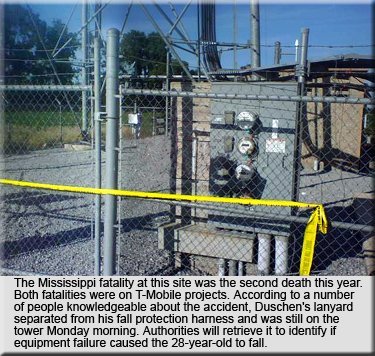 causing his death. causing his death.
"Let this be a lesson to all of you in this profession. Do not take for granted that you are 100% safe as there is never a guarantee. Please do routine inspections of your belts and harnesses," the distraught mother of three young girls said.
A number of people knowledgeable about the incident said that Duschen's lanyard is still attached to the tower this morning and he had his relatively new harness on when he was pronounced dead at the base of the 250-foot self supporting tower.
Officials have prohibited anyone from climbing the tower to retrieve it until a representative of OSHA is on site later today to receive the equipment to further assess what could have caused the accident.
The coroner's report identified that Duschen and co-worker Richard Rippee just finished lunch before he fell, but according to others close to the accident, the two tower technicians were up near the 217-foot level mounting frame preparing to receive transmission lines.
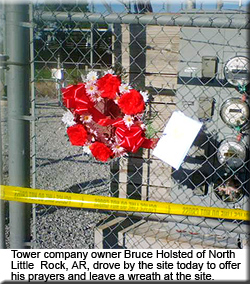 ------------------------------ ------------------------------
Update: June 6, 2009 - Visitation for family and friends of Shane Duschen will be on Sunday, June 7 from 1:00 p.m. to 2:00 p.m. at the Mid Town Baptist Church, 4037 Boone Rd., Benton, AR. Services will start at 2:00 p.m.
A memorial fund has been set up for his family and contributions can be made to:
Shane Duschen Memorial Fund, c/o Simmons First National Bank, Account #10836514, L/R Geyer Springs Branch, 8500 Geyer Springs Rd., Little Rock, AR 72209. For additional information, contact the bank at 501-570-0800.
------------------------------
June 4, 2009 - Shane Duschen, 28, of Alexander, AR, died yesterday afternoon after he fell 215 feet from a 250' self-supporting tower he was working on in Leland, MS.
He leaves his wife, Shanon, and their three daughters, age 7, 5 and 2.
Duschen was working with a four-man crew on a Crown Castle International tower off of Highway 61.
His employer, Diamond K Tower Co., Inc. of Greenville, was working directly for T-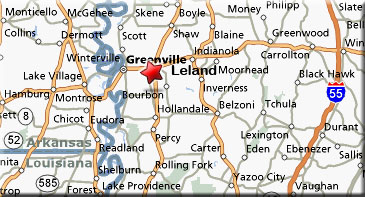 Mobile to install additional transmission lines. Mobile to install additional transmission lines.
Duschen, who began his employment with Diamond K Tower in 2002, was pronounced dead at the scene.
A 911 call was made by coworker Richard Rippee immediately after Duschen fell, according to Washington County Coroner Methel Johnson. The estimated time of Duschen's death was about 3:00 p.m.
Rippee said that he and Duschen had just finished eating lunch and were talking when Dushen simply fell from the tower, according to the coroner's report.
Johnson said Duschen was wearing a harness when he fell.
OSHA is on site investigating the fatality.
In addition to T-Mobile, the tower is co-located by Sprint PCS and AT&T Mobility.
Duschen's death is the second fatality this year of a communications technician falling from an elevated structure. A tower technician wearing a harness fell off a monopole on March 17 and died in Lake Worth, FL.
Owned by Mike Kuhn, who has 31 years of experience in the tower business, Diamond K Tower has specialized in cellular tower construction for the past 16 years.
|
|
With 15 events scheduled, state wireless associations will have their busiest June on record
June 4, 2009 - What appeared to be a pretty full calendar last June for state wireless associations has almost doubled this month as the groups hold events ranging from golf outings, planning sessions, socials, luncheons, panel discussions and even a skeet shoot. See: (Calendar) (SWAP News) (SWAP Associations).
June is being ushered in by a social this evening for Tennessee, Alabama and Georgia SWAs prior to their joint meeting tomorrow. On June 9, the Missouri/Kansas Wireless Association will host an informative luncheon presentation on safety with speakers Patrick Howey, Executive Director of NATE; David McDonnell, Kansas OSHA Manager; and Derald Price, Regional Implementation Manager, Verizon Wireless.
On June 24, New Jersey Wireless Association members will get a better idea of how much they can siphon from the $7.2 million stimulus broadband hope chest. The meeting's date might also coincide with an announcement of what exactly the definition of broadband will be. It could be services as low as 200 Kbps or it could be on the other extreme and be services providing 50 Mbps. Or, it could come down to typical DSL and 3G data speeds (768 Kbps up and 1-1.2 Mbps as a minimum), according to industry analyst Andrew Seybold.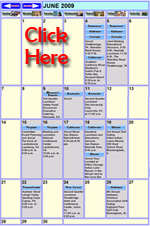
New Jersey Chamber of Commerce President Joan Verplanck will moderate the discussion to be provided by panelists Assemblyman Upendra Chivukula, Chair, New Jersey Telecommunications and Utilities Committee; Stefanie Brand, Esq., Director, New Jersey Department of the Public Advocate, Division of Rate Counsel; and Jason Hill of Media Venture Partners.
Alabama will end the month's events on June 26 with their 6th annual golf outing at Highland Park Golf Club in Birmingham.
There are 25 state wireless associations. The most recent group to hold its inaugural meeting in April was the Nebraska-Iowa association. President Michelle Roth welcomed attendees along with Vice President Terri Dolezal, Treasurer Pete McNally and Secretary Brandi Vandenberg.
|
|
National two man tower rule is on FAA’s agenda, but it's too late for 59-year-old worker
June 2, 2009 – The need to create a national fall protection standard for the Federal Aviation Administration for employees working on towers has been a concern for a number of months. a number of months.
It is expected to draw renewed attention at the FAA's Southern Region Occupational Safety, Health, and Environmental Compliance Committee scheduled for June 10 following the death of an employee who fell from a tower on May 29 while working alone without any safety equipment at the Palm Beach International Airport.
The deceased worker, 59-year-old Ismael Octtavanni-Mercado of West Palm Beach, who had fallen off a decommissioned 60-foot radar tower site a number of hours before being found, was not involved in installing or maintaining any communications equipment, according to an Atlanta FAA spokesperson.
At the FAA regional meeting on February 25, Engineering Services Representative Steve Hardee gave a draft presentation about requiring two people for all climbs. They would be required to be First Aid and CPR trained, and that one be rescue trained for climbs that are off the safety ladder system and on towers over 100 feet tall. The committee recommended that both climbers be rescue trained.
It was also recommended at the FAA meeting that the "corporate impacts regarding staffing this requirement" be discussed with comptrollers.
“For safety reasons, NATE has long been an advocate of having a minimum of two tower climbers on site for all projects,” said National Association of Tower Erectors Chairman Jim Coleman, upon learning of Octtavanni-Mercado’s death Friday and the FAA’s desire to provide a safe environment for their technicians required to work on towers.
“Beyond that, the association has been working with the Occupational Safety and Health Administration for a number of years on the creation of a federal tower safety standard. The most recent example of such a standard has been established by the State of Michigan. This standard makes it clear that two workers should be on each site and also includes realistic examples of how the rescue component of a safety standard should be addressed,” Coleman said.
Michigan and North Carolina could provide a starting template
The FAA committee could take advantage of the extensive research and promulgation efforts of NATE and members of Michigan’s and North Carolina’s state occupational safety and health organizations.
Effective in April, Michigan’s new communications tower standard addresses a requirement ensuring that at least two rescue-trained employees are on site when employees are working at heights over six feet on the structure.
When there are only two employees on site and one of the employees has been employed for less than 12 months, then the new employee must minimally have documented rescue training which includes steps to be taken in an emergency.
North Carolina’s 2005 fall protection standard requires that at least two trained and designated rescue employees must be on site when employees are working at heights over six feet on the tower, provided however, where there are only two employees on site, then an employer may comply with the requirements of the standard if one employee is a trained and designated rescue employee and one employee has been designated by the employer as a probationary employee and has been employed for less than nine months.
|
|
FAA worker falls to his death at Palm Beach airport
Updated: June 1, 2009 - The Palm Beach County Sheriff's Office said that 59-year-old Ismael Octtavanni-Mercado of West Palm Beach was doing monthly maintenance on portable generators used during hurricane season that are stored inside a building at the foot of a decommissioned air surveillance radar tower just prior to his death.
After servicing the generators, Occtavanni-Mercado went up to the third section of the tower with tools, in an attempt to salvage light fixtures that could be reused elsewhere at the airport.
"It appears that he lost his footing, hitting a couple of beams before landing on the rocks beneath the tower," according to Teri Barbera of the sheriff's office.
The FAA employee was not wearing personal safety equipment and did not work on communications towers, according to an official familiar with the accident.
- - - - - - - - - - - - - - - - - - - - - - - - - - - - - -
May 30, 2009 - Authorities say that news reports that a man who died while he was working on a decommissioned radar tower at Florida's Palm Beach International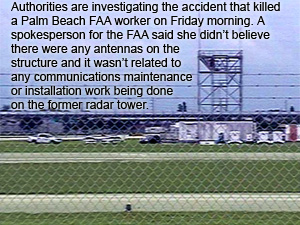 Airport was a contracted technician were incorrect. The man was a Federal Aviation Administration employee. Airport was a contracted technician were incorrect. The man was a Federal Aviation Administration employee.
The worker, whose identity was not released, fell Friday morning while he was working on the four-legged structure that is approximately 60-feet tall.
The Palm Beach County Sheriff's office did not identify if the man was wearing personal fall protection equipment or why the employee was on the tower.
FAA spokeswoman Kathleen Bergen said it appeared that the man "fell from the platform of a decommissioned radar antenna."
Authorities believe that he was working alone and said there were no eye witnesses to the tragedy that happened sometime after 11:00 a.m.
Bergen said she was informed that the structure had been decommissioned several years ago, was not being used for communications antennas and it is currently unknown why the man was on the tower.
FAA representatives from Atlanta were in route to the airport to assist in the investigation, Bergen said.
The man was a technical operations employee whose job was to install and maintain FAA equipment at the airport, Bergen said.
The sheriff's office and OSHA are also investigating the death.
|
|
New border crossing rules will prescreen some tower tech job applicants seeking Canadian work
June 1, 2009 - U.S. residents will need passports or high-tech documents to re-enter the country from Canada or Mexico under new rules taking effect today.
Although US Customs officials say they're confident the transition will be smooth, it is expected that it will make it even more difficult for Canadian tower companies to lure much needed tower technicians across the border.
Some technicians do not have a US driver's license and now it will be even more difficult since an enhanced driver's license, which has extra security features, can only be used to cross the northern as well as southern borders if the technician does not have a passport.
Vermont, New York, Washington state, and Michigan are the country's four states offering the enhanced driver's licenses.
Two of Canada's carriers are integrating a GSM High Speed Downlink Packet Access alongside their CDMA networks. Much of the installation work is brand new to most technicians and the demand for additional workers is challenging.
Riggers have to run 12 or 24-count fiber cables from the tower mounted GSM radios as well as power them. Generally, up to 16 runs of 8 AWG come from the tower into the shelter where technicians are required to test and install them.
Standard driver's licenses or birth certificates will no longer be enough under the rules, which have gradually been tightened since the Sept. 11 attacks. Travelers not complying with the new requirements will get a warning and be allowed to enter the U.S. after a background check.
|
|
It's back to the bird battle with new petition
May 31, 2009- The American Bird Conservancy, Defenders of Wildlife, and the National Audubon Society have filed a petition for expedited rulemaking and other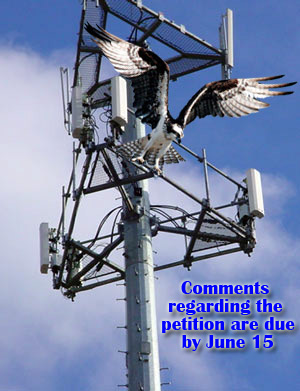 relief. The petitioners request that the Commission adopt new rules on an expedited basis, which they assert are necessary to comply with the National Environmental Policy Act (NEPA), the Endangered Species Act (ESA) and the Migratory Bird Treaty Act (MBTA), and their implementing regulations, and to carry out the mandate of the U.S. Court of Appeals for the District of Columbia Circuit in American Bird Conservancy, Inc. v. FCC (516 F.3d 1027, D.C. Cir. 2008). Specifically, the petitioners request that the FCC undertake several actions: relief. The petitioners request that the Commission adopt new rules on an expedited basis, which they assert are necessary to comply with the National Environmental Policy Act (NEPA), the Endangered Species Act (ESA) and the Migratory Bird Treaty Act (MBTA), and their implementing regulations, and to carry out the mandate of the U.S. Court of Appeals for the District of Columbia Circuit in American Bird Conservancy, Inc. v. FCC (516 F.3d 1027, D.C. Cir. 2008). Specifically, the petitioners request that the FCC undertake several actions:
-- Amend the Commission's regulations that implement NEPA, "consistent with Council on Environmental Quality regulations and guidance," to "cure deficiencies" and to ensure that only Commission actions that have no significant environmental effects individually or cumulatively are categorically excluded;
-- Prepare a programmatic environmental impact statement addressing the environmental consequences of its Antenna Structure Registration ("ASR") program on migratory birds, their habitats, and the environment;
-- Promulgate rules to clarify the roles, responsibilities and obligations of the Commission, applicants, and non-federal representatives in complying with the ESA;
-- Consult with the U.S. Fish and Wildlife Service on the ASR program regarding all effects of towers and antenna structures on endangered and threatened species; and
-- Complete the proposed rulemaking in the Migratory Birds Proceeding to adopt measures to reduce migratory bird deaths in compliance with the MBTA.
The FCC is accepting comments on the petition. They must be submitted by June 15.
|
|
Working Chicago's high side, he's been changing the skyline, one tower at a time
May 26, 2009 - Next month for $14.95, Chicago's Sears Tower will invite its Skydeck visitors to step out onto its new glass enclosed observation deck on the nation's tallest building and enjoy the dizziness-inducing splendor of the city 103 stories below.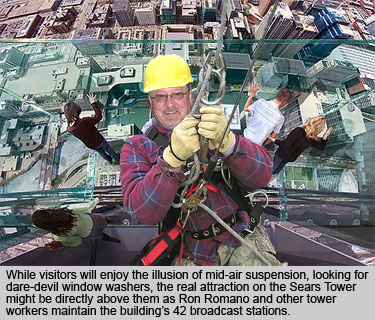
It's not that he's frugal, but it's doubtful that Ron Romano will be buying a ticket anytime soon since the veteran tower erector has the opportunity almost every day to see even more spectacular views at considerably higher elevations.
In fact, while visitors will be enjoying their windy city view, Romano might be hanging high above them working on one of the iconic broadcast antennas the building is known for.
As president of Installation Services, Inc. of Genoa, Il., Romano proudly notes that since 1983 when his business was established it has helped change the Chicago skyline four times.
Over the years, Installation Services has built everything and installed all antenna communications systems and their components on the Sears Tower. Today, there are 42 broadcast stations atop the building.
Romano has described and demonstrated his work on The Today Show and Good Morning America, as well as the Discovery and History Channels. He said he has probably done tower work for every TV station in the country at some point over the 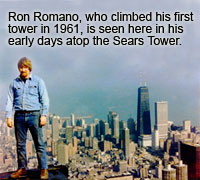 years. years.
A friend's father got Romano his first job climbing towers in 1961, during an industry period when safety wasn't a priority for many companies.
He is particularly fond of a photograph showing him as a younger man precariously standing atop the Sears Tower, seemingly taunting the abilities of a strong gust of wind.
However, Romano, like a number of industry professionals, saw the need for companies to embrace safe working practices and helped found the National Association of Tower Erectors in 1995.
Since then he has been a guiding force in working with OSHA and helping to promulgate safety standards for the industry. He is highly regarded by his fellow NATE directors.
"I want my workers to come home at night," Romano said.
The exacting disciplines of Romano's specialized work requires that safe rigging and adherence to safety by climbers is his firm's top priority. The affable owner says that his employees, numbering approximately 15, know that safety is the company's culture and not the often touted slogan that is not enforced.
Romano says that tower workers must be comfortable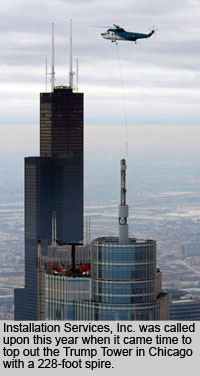 working at great heights, but must always be 100% tied off and should never become too relaxed with their ever-changing environment. working at great heights, but must always be 100% tied off and should never become too relaxed with their ever-changing environment.
"Come to think of it, maybe I'll just have my next climber walk out on the Sears observation deck and see how he reacts before I hire him," laughed Romano, who recognizes the training and considerable cost necessary to bring on a new employee that might not be cut out for tall tower work.
Romano's company is in high demand throughout the US as well as internationally. Although there are no broadcast antennas in the Chicago Trump Tower spire, Installation Services was hired last January to top off the building with the 228-foot column.
The work required setting 13 three-legged lattice sections covered by a painted fiberglass shroud, some of them weighing up to 20,000 pound each. The sections tapered from 10-feet to 4-feet.
The final 20-foot sections were lifted by a Sikorsky S-61 helicopter. If the installation wasn't challenging enough, Romano's crew had to endure 20-degree F weather, light rain and wind gust up to 25-miles-per-hour - as recorded far below them on Michigan Avenue.
Romano has a considerable amount of helicopter lifts under his climbing belt, his first major project taking place in 1982 when he used a helicopter to build a communications project on the Sears Tower.
When Romano has a few hours of leisure time available, he says the only steel that he wants to hold is a nine iron with his feet firmly planted on the greens.
|
|
New tower construction standard gets considerable airing from NAB
May 18, 2009 - The National Association of Broadcasters says that towers can be magnificent structures and are a vital part of the broadcast industry infrastructure. The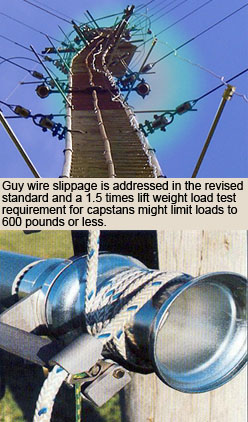 trade group accepts the fact that the construction and maintenance of tall towers is at times perilous and they're embracing a new Telecommunications Industry Association construction standard in the works. trade group accepts the fact that the construction and maintenance of tall towers is at times perilous and they're embracing a new Telecommunications Industry Association construction standard in the works.
In its newsletter last week, the NAB reported that the topic was discussed during the Broadcast Engineering Conference on April 22, but the association wanted to again focus upon the need for the new standard and, following compliance, reaching a goal of lowering construction accidents and structure collapses.
Don Doty, CEO of Stainless LLC, and Ernie Jones, Senior Engineer, ERI, presented an educational session on the Structural Standards for Installation, Alteration and Maintenance of Antenna Supporting Structures, ANSI/TIA-1019 Standard. Their detailed slide presentation can be seen here .
Jones is co-chairman of the TR-14.7 Subcommittee developing the standard along with Gordon Lyman of WesTower Communications. Brian Reese of AeroSolutions, LLC is Chairman of the TIA TR14.7 Committee.
The National Association of Tower Erectors collaborated on the tower construction and rigging protocol and procedures in the standard.
Major tower failures have happened while crews were performing an erection, maintenance or retrofitting. Although wireless carriers' towers are not immune to these accidents, broadcast tower failures seem to occur at a greater degree of frequency.
Tall towers require special rigging and there are a limited number of available crews to erect and service them.
The most recent collapse occurred on May 8 when a 1,056-foot guyed tower in Joplin, MO fell when high winds buffeted the area.
A tower crew from Precision Communications, Inc., of Grove, OK, had been working on the KSNF-TV structure prior to the storm upgrading the antenna so that the station could become fully digital. A gin pole had been attached to the top of the tower creating additional loading as winds, said to be as high as 100-miles per hour at the top, swept through the site.
Please see: Loads on structure considered during construction
|
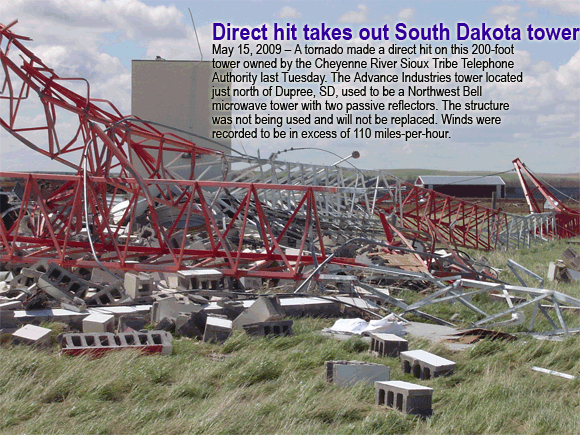 |
|
Miami tower erection crew resumes stacking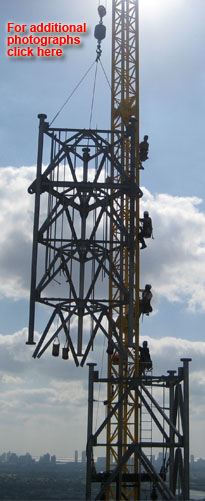
May 11, 2009 - The Tower King ll erection crew will begin stacking steel again today on the 1,000-foot North Miami, FL DTV tower.
You can view the daily erection progress here as they continue to erect over a million pounds of steel.
The 12-foot-wide face sections weigh up to 26,500 pounds and leg diameters go up to 7.5 inches.
The massive guyed tower with a base foundation 50-feet below grade will have a two man elevator.
The WPLG Channel 10 CBS tower is located near the Broward and Miami Dade County borders and is located in one of the tallest antenna farms in the nation.
The erection began April 12 and continued until April 30. However, critical material deliveries and scheduling conflicts caused the stacking side of the project to be held off until today.
The tower is currently at 740-feet and the remaining sections and candelabra are expected to be completed in the coming weeks, according to Kevin Barber, President of Tower King ll.
For additional photographs, click here .
|
|
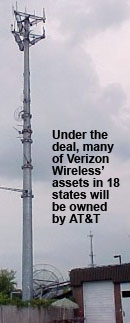 AT&T to acquire Verizon Wireless' AT&T to acquire Verizon Wireless'
properties in 18 states
May 11, 2009 - AT&T announced a definitive agreement to acquire wireless assets from Verizon Wireless for $2.35 billion in cash. Under terms of the agreement, AT&T will acquire wireless properties, including licenses, network assets and 1.5 million current subscribers in 79 service areas, primarily in rural areas across 18 states.
Verizon Wireless is required to divest these properties as part of the regulatory approvals granted for its purchase of Alltel earlier this year. The states represented are: Alabama, Arizona, California, Colorado, Iowa, Kansas, Michigan, Minnesota, Montana, Nebraska, Nevada, New Mexico, North Dakota, South Dakota, Tennessee, Utah, Virginia and Wyoming.
After operations transition to AT&T, the primarily rural subscribers added through this transaction will be able to experience mobile broadband on all the smartphones AT&T offers.
The deal is expected to close in the fourth quarter of 2009, contingent on regulatory approval, AT&T said.
Verizon previously had said more than 30 companies had expressed interest in the Alltel assets.
Moody's Investors Service said it has changed its outlook for the debt ratings of AT&T to negative from stable after viewing the Alltel assets purchase from Verizon Wireless.
Moody's said the outlook change reflects its "concern that given the increase in debt over the last two years (including debt likely to be incurred for pending acquisitions), weak economic conditions and the likelihood of slower growth and increased competition in the wireless business."
|
|
Missouri TV tower collapse spares Joplin family as they hide in bedroom closet
May 8, 2009 - Part of KSNF-TV's guyed tower collapsed early this morning in Joplin,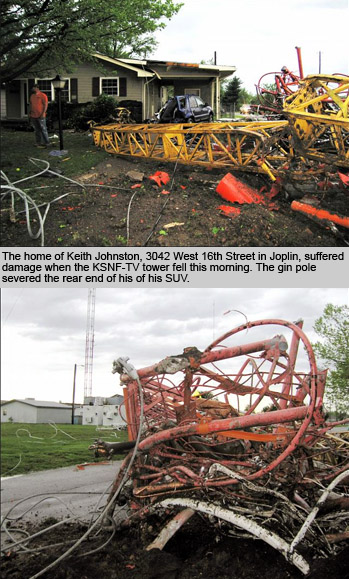 MO, crushing a vehicle and causing damage to homes in its path. MO, crushing a vehicle and causing damage to homes in its path.
No injuries were reported by emergency personnel following the 7:00 a.m. tower failure that is being investigated by station engineers and police.
Over half of the television tower fell and damaged the TV studio as well as the homes.
Initial reports from residents say that winds came through the area immediately preceding the NBC affiliate's tower's collapse. Winds at the time were recorded in excess of 80 miles per hour.
Tower technicians had been working on the structure in recent days upgrading the antenna so that the station could become fully digital.
A gin pole and antenna fell upon the home and vehicle of Keith Johnston of West 16th St.
Access to the area has been restricted due to downed power lines.
Although Johnston's Ford Escape was severed, his wife and two children escaped serious injury. They had been taking shelter in the home's bathroom, but Johnston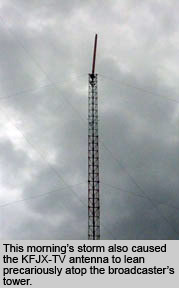 said his wife had an eerie feeling and ran to the bedroom closet. Moments later, the tower collapsed and part of it fell into the bathroom. At first, they thought a large tree had fallen on their home. said his wife had an eerie feeling and ran to the bedroom closet. Moments later, the tower collapsed and part of it fell into the bathroom. At first, they thought a large tree had fallen on their home.
Observers in Joplin reported hail three-quarters of an inch in diameter during the storm.
Jeff Hadley, chief engineer at the station, said everyone in the studio was able to get out before the tower fell.
The structure was originally 1,056 feet tall. Now, only 350 feet of the tower remains standing, Hadley said.
"There are too many variables to say exactly when we will be back on the air. Right now, we're looking at 30 days as a time frame," said John Hoffman, the station's general manager.
"We won't have a tower up by then, but we have several options available to us to get back on the air that don't require a tower, and that's what we are working on. We'll put a tower up. That's without question."
This morning's storm also caused the KFJX-TV antenna to lean dangerously atop the broadcaster's tower.
Click here for additional pictures of the KSNF-TV tower .
|
|
Judge gets tough on tower site thefts
May 7, 2009 - If you steal from a tower site in Taney County, MO, be prepared for a stiff sentence if you're caught, as Carl Thompson, 45, of Rockaway Beach found out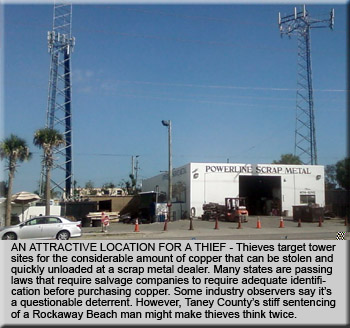 today when the Missouri 38th Judicial Court handed down a lengthy sentence for the crime. today when the Missouri 38th Judicial Court handed down a lengthy sentence for the crime.
After pleading guilty, Thompson received seven years for the burglary, seven years for stealing, and four years for resisting arrest.
The two seven year-terms will run concurrently, but the four-year term will run consecutively.
Thompson could be eligible for parole after serving five years of his 11-year term.
In May 2008, Thompson was caught in the act of scrapping out air conditioners at a tower site in Hollister, owned by Frosty Towers Inc.
He had also stripped the copper ground system from the site, removed the control wiring from the generator, cut fiber optic lines going into the building, among other things.
He then went to a tower site next door, destroying the AC unit and knocked radio station KSMU off the air.
He came back to the Frosty Towers site and was arrested by the Taney County Sheriffs Department, after being tazed.
The prosecutor said he was happy to see Thompson receive a firm sentence, as the problem is an epidemic, according to Blake Bowers of Frosty Towers.
|
|
Say it ain't so, Sprint, some say
Ericsson's bid to manage Sprint's construction could be vexing for contractors
May 4, 2009 - In an effort to cut costs, Sprint Nextel appears to be in final negotiations to outsource management of its cellular network to equipment vendor Ericsson, according to The Wall Street Journal. according to The Wall Street Journal.
The struggling cell phone operator could end up paying Ericsson as much as $2 billion over several years to maintain the thousands of cell sites that carry Sprint's wireless voice and data traffic.
The WSJ quotes their sources as saying the deal could slash Sprint's network costs by about 20 percent.
Part of those cost savings would likely come from shifting between 5,000 and 7,000 service employees to Ericsson.
According to reports, Alcatel Lucent and Nokia Siemens dropped out of the bidding after identifying that Sprint's terms wouldn't allow the companies to make money, and Ericsson would be working at a loss to expand into the North American market.
Unfortunately, many company owners say, it's likely that Ericsson will try to cut their losses by taking it out of the already thin-margin-hides of contractors.
"Do I think it would reduce my margins? That's laughable," said one New York installation contractor who stated that he has been forced to work below cost on an Ericsson-managed T-Mobile project.
"We could have squeaked by, but their management is terribly disorganized and any error on their part is always the responsibility of the contractor to fix," he said.
A number of other contractors working in the northeast on T-Mobile contracts echo similar concerns about Ericsson's project management.
"This has been a train wreck from day one," explained one contractor who cited equipment issues that are forcing his crews to return to sites without any compensation for remobilization.
"Like a number of other management firms, their primary interest is to show construction starts, even if they know that the contractor will be incapable of completing it," he said.
Ericsson's closeout documentation for T-Mobile work came under fire from all contractors interviewed. "It's a nightmare," was a kinder comment offered.
There was general agreement that Ericsson wants contractors to do as much of the administrative work as possible. "So, what value does Ericsson's project manager bring to the table?" questioned a seasoned Pennsylvania construction executive.
"All they do is to try to beat you up to meet their matrix and then threaten to cut you loose if you press a change order issue or can't meet their deadline," he said.
If Ericsson is awarded the nation's third largest carrier's outsourcing contract for network planning, civil construction, installation, testing and network optimization, some contractors believe that the Sprint work will be equally as disorganized as the T-Mobile 3G buildout.
An east coast contractor sees the Sprint/Ericsson glass as being half full, hoping that Ericsson learns from contractor conflicts that have arisen during its management of recent T-Mobile projects.
"They need to bring in some real pros who know how these things have to go," he said. "They have to put the right people in the right job and not expect contractors to donate their services."
He believes that Ericsson must insist upon having a very well-defined scope of work of what Sprint wants to accomplish.
"It's all about expectations and having the right partner, and treating your subcontractors and partners well. I have high hopes that someone will get smart about this," he said.
Contractors oftentimes complain about the high number of carrier and development managers that are brought into the industry with a limited knowledge about the work they are tasked to administer.
"Some of them are additionally compensated if they bring the project in on time and under budget, which makes the contractor and client relationship adversarial on day one," said a New Jersey contractor.
Ericsson declined to comment on the reported Sprint transaction or current contractor relations with its T-Mobile projects.
If the deal goes through, Sprint is expected to retain ownership of its cell towers and would continue to be responsible for capital investments.
Sprint's total mobile customers declined by 182,000 to 49.1 million by the end of the last quarter, although this was a significant improvement from the 1.3 million customers lost in the previous quarter.
|
|
NATE chairman cautions industry not to let its guard down due to lower fatality rate
May 1, 2009 - Although there has only been one fatality of a telecom worker falling to his death during the first four months of 2009 - the lowest fatality rate in the past six years - NATE Chairman Jim Coleman is cautioning climbers that the single death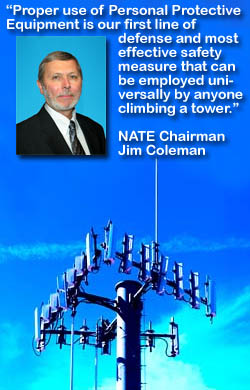 shouldn't be viewed as a signal that the annual fatality rate is trending down. shouldn't be viewed as a signal that the annual fatality rate is trending down.
Citing statistics from 2008 when five technicians died in April during a 12-day period, and seven deaths during May of 2006, Coleman said that it's important to view the entire year and not specific monthly milestones.
"As we enter into another busy construction season, the National Association of Tower Erectors believes it is imperative that everyone in the tower industry come together and make the daily effort of recognizing the potential hazards faced on each job site to prevent accidents from happening," Coleman said.
A number of contractors have said that second quarter projects were down appreciably, but carriers seem to be ramping up and moving some stalled NTPs into their third quarter.
If this is the case, Coleman said, he's happy to see a vibrant industry, but he hopes that unreasonable deadlines aren't placed by the carriers.
"Dedication to safety is a continuous effort. It is essential to create a culture of safety for your company on a daily basis. Increased safety awareness and fewer on-the-job injuries will result in more employees' lives being saved and an increase in the company's bottom line. The rush to fix a problem or deploy a site can seem overriding, but the cost of an accident is far more disruptive to a company than any service outage. Do not be pushed to complete tasks faster than they can safely be performed," Coleman said.
He said he's convinced that keeping safety top of mind is critical to the success of workplace safety programs and the industry overall.
"Each and every one of us must take the steps to ensure that our companies have established and implemented the necessary safety practices and procedures before every project begins."
"Proper use of Personal Protective Equipment is our first line of defense and most effective safety measure that can be employed universally by anyone climbing a tower," Coleman said.
He noted that most accidents have proven not to be the result of faulty equipment, but rather human error involving the improper use or lack of safety equipment, the lack of proper training and preparation, poor communication, taking shortcuts, working in unsafe conditions or plain old carelessness.
"If we remain vigilant and take the necessary measures to ensure safety, we can raise employee morale and stop accidents from occurring," Coleman said.
To ensure that your PPE is safe to use, NATE recommends that you or your designated competent person must perform daily equipment inspections. Any worn, damaged or improperly functioning equipment must be removed from service immediately. They also state that audits of your company's safety practices need to be conducted on a regular basis to ensure employees are putting their training into practice, and 100% fall protection should be mandated at all times, regardless of the height of the job.
|
|
Tower techs arrested for Ohio line thefts
April 26, 2009 - Carroll County Ohio police arrested four Ohio residents last weekend, and further investigation resulted in the arrest of an additional four people who have reportedly been stripping copper from communications sites throughout the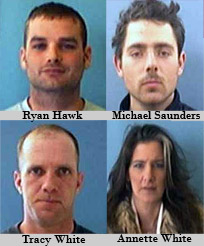 state for the past two years. state for the past two years.
An additional suspect is being sought by authorities, the sheriff's office said Thursday.
Sheriff Dale Williams said all four communications towers in Carroll County were hit, but the sheriff said the group may have stolen copper from as many as 50 towers in the state.
Sheriff Williams said a number of the suspects may be connected to thefts from communications towers in Columbus, Cleveland and Cincinnati, among other places, and he is asking law enforcement agencies to contact him to identify if those arrested in his county were responsible.
Several of those arrested were tower technicians, the sheriff informed WirelessEstimator.com, but he could not readily identify who those suspects were. It is suspected that some of the thefts might have been done while the techs were still working for tower service companies.
Sheriff Williams said they were trained to work on towers and they stole the copper transmission lines openly during the day as well as at night.
Investigators believe that because they were adept at climbing that a number of thefts were probably observed by witnessed who thought they were contractors working on the structure.
Tracy White, Annette White, Ryan Hawk and Michael Saunders were the first group to be arrested and were charged with several felony counts each of theft, breaking and entering, and receiving stolen property.
Jody McDougal and Wade Armstrong were later arrested and the sheriff's officers arrested another two people on Wednesday. As of today, the ninth suspect hasn't been apprehended.
|
|
Michigan's new tower safety standard becomes second state regulation to protect workers
April 21, 2009 - The Michigan Occupational Safety and Health Administration's new safety standard for the construction of communications towers went into effect on  April 10 to protect workers on broadcast and communications towers. Michigan is the second state to specifically address tower safety, following North Carolina's introduction of tower regulations in 2005. April 10 to protect workers on broadcast and communications towers. Michigan is the second state to specifically address tower safety, following North Carolina's introduction of tower regulations in 2005.
The MIOSHA requirements provide the minimum protection for Michigan tower workers when working at heights over six feet during construction, altering, repairing, operating, inspecting, maintaining, and demolishing broadcast and communication towers.
Terry Sharp, President of Grant Tower, Inc., Grant, MI, and who also served on the National Association of Tower Erectors' Board of Directors for the past 14 years, helped guide the efforts to develop up-to-date safety laws that ensure tower workers arrive home safe every day.
As co-chairman of the tower safety advisory committee, Sharp contributed his industry knowledge throughout the decision-making process and helped drive home NATE's key safety requirements.
NATE members working on this committee from the state of Michigan also included Terry Martin of Northern Tower Erection Co. in Traverse City and Vincent Palazzolo from Northern Tower Connection in White Lake.
The MIOSHA regulation is another important step in the right direction for establishing a national program that will provide consistency for tower safety rules and requirements, helping to drive the adoption of an industry-wide culture of safety, according to Sharp.
The standard had a public hearing last July with little opposition. One attendee questioned potential conflicts with existing standards that relate to towers that support high voltage lines. The commission reviewed additional language proposed to address this concern.
Sharp said that committee members evaluated the new content to ensure that employees of utility companies that service high voltage lines as well as communication towers are accountable under the tower standard for their relevant communications work.
|
|
Man suspected of stripping cell phone towers appears to have industry ties
April 17, 2009 - Two individuals have been charged with stealing $30,000 in items from cell phone towers in Monroe Township, NJ, police said today.
Louis W. Wright, 28, of Somerdale, and Joseph J. Masino IV, 26, of Atco, each were charged with burglary, theft, criminal mischief, conspiracy and possession of burglary tools. Wright was committed to the Gloucester County Jail, Woodbury, in lieu of $75,000 cash bail. Masino was released.
The pair are accused of stealing electronic equipment from AT&T and Nextel cell phone towers in the Twelve Oaks Development.
Officer Kevin Bielski, on patrol about 4 a.m. Thursday, spotted one vehicle on Bonnie Blue Circle that was not frosted over like other vehicles in the neighborhood.
Electronic equipment and wiring were visible inside the vehicle, police said. Wright and Masino were located in a nearby wooded area.
An investigation determined Wright formerly worked at a job involving cell towers, said Police Lt. Tony Pace.
"He used that knowledge to target multiple cell tower locations," said Pace, noting a tower was not far from the Twin Oaks development.
A court-obtained search warrant revealed items stolen from AT&T and Nextel towers. Police indicated at least six cell phone towers in different municipalities may have been targeted.
Texas man dies when guy wire snaps
April 16, 2009 - A 44-year-old Tyler, TX man, who was not employed as an experienced tower worker, died Wednesday afternoon when a tower he was helping take down fell with him attached to it.
The victim was identified as Manuel Rivera Sr.
Rivera, the owner of ROCS Wireless Services, fell about 60 feet and died at the scene, said Smith County Sheriff Lt. Larry Wiginton.
Wiginton said the tower toppled when a guy wire snapped.
The company was in the process of trying to remove the tower located at U.S. Highway 271 and Loop 323, Wiginton said.
|
|

|
|